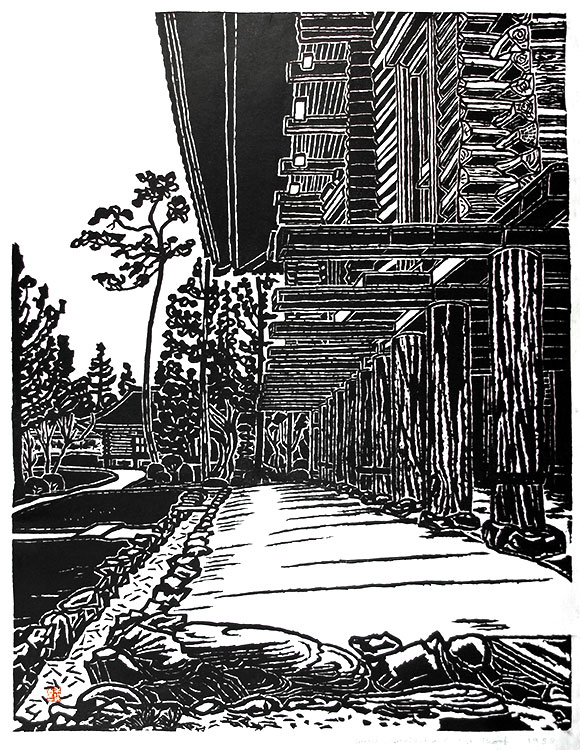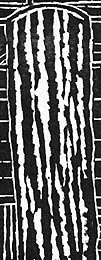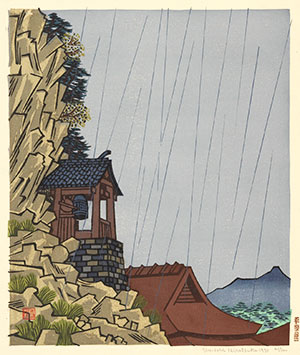

HIRATSUKA Un'ichi (平塚運一)
|
Hiratsuka Un'ichi (平塚運一), one of the pre-eminent figures in the sôsaku hanga (creative prints: 創作版画) movement, was born in Matsue, Honshû. In 1913 he met the artist Ishii Hakutei (1882-1958), a western-style painter and printmaker who had published the first sôsaku hanga print (Yamamoto Kanae's "Fisherman") in the magazine Myôjô (Morning Star: 明星) in 1904. Ishii admired Hiratsuka's painting, and in 1915 the younger artist moved to Tokyo to continue his study with Ishii, who urged him to learn block carving and printing. He did so for about six months with Igami Bonkotsu (伊上凡骨 1875-1933), becoming the best-trained block carver in the sôsaku hanga movement. Hiratsuka exhibited his first prints in 1916 at an exhibition of the independent Nika-kai ("Second Division Society"), and by the 1920s his reputation in the world of printmaking was considerable.
 |
| Hiratsuka: Shôsôin, Nara (正倉院奈良), 1958 (image: 762 x 590 mm; paper: 827 x 632 mm) |
It is likely that Hiratsuka had some influence upon nearly every important second-generation sôsaku hanga artist. He published the book Hanga no gihô (Printmaking techniques: 版画の技法) in 1927, from which many artists first learned about how to produce creative prints. He taught sessions on woodblock printing in various parts of Japan, inspiring, among many students, the great Munakata Shikô, who learned to use the v-shaped chisel from Hiratsuka when they first met in 1928. During the 1930s he led an informal group of artists, the so-called Yoyogi-ha (Yoyogi clique: 代々木派), who gathered at his house in the Yoyogi district of Tokyo. Between 1935 and 1944 Hiratsuka taught the first hanga (block printing: 版画) course at the Tokyo Bijutsu Gakkô (Tokyo School of Fine Arts: 東京美術学校), where Fumio Kitaoka and Okiie Hashimoto were among his students. In 1948 he established his own school in Tokyo.
 Hiratsuka moved to Washington D.C. in 1962, and continued designing prints and teaching through occasional demonstrations. In June 1968, for example, in an event co-sponsored by the Washington Print Club and held at the Washington Gallery of Modern Art, he demonstrated his carving techniques and printed several designs as an overflow audience watched the master craftsman and artist. Included among the works he printed that day was an impression of the 1966 design "Covered Bridge, Pennsylvania Dutch Country" (520 x 600 mm); see image at right.
Hiratsuka moved to Washington D.C. in 1962, and continued designing prints and teaching through occasional demonstrations. In June 1968, for example, in an event co-sponsored by the Washington Print Club and held at the Washington Gallery of Modern Art, he demonstrated his carving techniques and printed several designs as an overflow audience watched the master craftsman and artist. Included among the works he printed that day was an impression of the 1966 design "Covered Bridge, Pennsylvania Dutch Country" (520 x 600 mm); see image at right.
Hiratsuka's daughter, Keiko Hiratsuka Moore, reported that her father considered the dating and numbering of his prints to be a nuisance, a practice expected by Western collectors, but not one that was compatible with his own views. At times, Hiratsuka, perhaps mischievously, randomly numbered some impressions or made up the size of editions. Thus we are faced with the possibility that impressions of Hiratsuka's prints may occasionally have misleading edition numbers. She also said that, typically, her father rarely made more than a dozen or so of most of his designs. In contrast, Oliver Statler, who interviewed Hiratsuka, wrote in the mid-1950s that Hiratsuka's editions typically ran between 30 and 50 impressions. There are certainly known exceptions, such as one image of Saint Nichiren, intended for an edition of 10,000 in the manner of devotional Buddhist images (Hiratsuka was a serious collector of old Buddhist prints, some dating from the late Heian period, 898-1185); however, Hiratsuka managed "only" around 1,475 impressions. At the opposite end of the range, Hiratsuka's design of the Lincoln Memorial to commemorate the 1975 visit to the U.S. of the emperor and empress of Japan was made in a single impression for the exclusive possession of the Imperial household. Generally speaking, it appears that Hiratsuka often printed only as many copies of his works as were needed or requested over the years, so more research is needed to sort out the number of extant impressions for each of Hiratsuka's designs.
 Hiratsuka's grandfather was an architect who designed houses and temples, and his father was a shrine carpenter, so the artist was introduced to wood-working and architecture early in his life. The image shown at the top of this page depicts the Shôsôin at the Tôdai Temple in Nara, the famous eighth-century repository of Imperial treasures. Printed in 1958, it is a large-format work measuring 762 x 590 mm (paper size, 827 x 632 mm). The stark contrast between the white paper and dense black is complemented by a bold, receding perspective seen from a low vantage point. The overhanging roof runs right to the top edge of the image and the massive wooden beams jut out in evenly spaced, rhythmical horizontals. The mass of architectural and garden detail is further energized by Hiratsuka's characteristic carving, a technique he developed called tsukibori ("poking strokes") made with small square-end chisel (aisuki), rocking the blade side to side in short strokes. This produced rough, jagged edges that he used in selected areas of the design (see the detail of a column on the immediate right). Hiratsuka said, "This rough line came out of my search for greater strength and a feeling of solid mass."
Hiratsuka's grandfather was an architect who designed houses and temples, and his father was a shrine carpenter, so the artist was introduced to wood-working and architecture early in his life. The image shown at the top of this page depicts the Shôsôin at the Tôdai Temple in Nara, the famous eighth-century repository of Imperial treasures. Printed in 1958, it is a large-format work measuring 762 x 590 mm (paper size, 827 x 632 mm). The stark contrast between the white paper and dense black is complemented by a bold, receding perspective seen from a low vantage point. The overhanging roof runs right to the top edge of the image and the massive wooden beams jut out in evenly spaced, rhythmical horizontals. The mass of architectural and garden detail is further energized by Hiratsuka's characteristic carving, a technique he developed called tsukibori ("poking strokes") made with small square-end chisel (aisuki), rocking the blade side to side in short strokes. This produced rough, jagged edges that he used in selected areas of the design (see the detail of a column on the immediate right). Hiratsuka said, "This rough line came out of my search for greater strength and a feeling of solid mass."
Hiratsuka believed that the combination of black and white had a special and challenging beauty. To be successful using only these two colors, an artist had to capture the rhythm of line and mass. White was not merely negative space, but a value equal to black, and each color had to harmonize with the other. To achieve this, Hiratsuka once said, "I make my black as intense as I can get it. My black ink is the very finest sumi from Kyoto, and I make impression after impression until the color seeps deep into the paper."
The rhythm of lines and forms is sometimes as much the subject of an image as the scene being depicted. In Hiratsuka's "Rock Creek in Montrose Park, Washington, D.C." from 1962 (see below), the agitated black lines of the creek assert an intense visual impact on the observer, enhanced by Hiratsuka's tsukibori technique, as movement overwhelms the stasis of the rocks. The view is filled with details from edge to edge, and the narrow white spaces are as critical to the impact of the design as the black lines and forms.
 |
| Hiratsuka: Rock Creek in Montrose Park, Washington, D.C., woodcut, 1962, ed. 80 (image: 435 x 520 mm) |
Although Hiratsuka's best works were printed in sumi pigment only, he also made full-color prints. A well-known example is his Ame no Yabakei, Rakan-ji (Rain at Rakan Temple, Yabakei: 雨の耶馬渓羅漢寺) from 1935 (see below left). Rakan-ji (羅漢寺) in Oita prefecture is a Sôtô (曹洞) temple, the largest of the three traditional sects of Zen in Japanese Buddhism. It is situated on the rocky cliff edge of Mt. Rakan, which also has numerous caves where more than 3,700 stone Buddhas are enshrined. The temple was established in 1337, but was destroyed by fire in 1943. Thus Hiratsuka's woodcut depicts the temple only about eight years before its destruction. The temple is shown from the side, tucked into the lower left of the scene, while the light-blue-gray sky and falling rain occupy most of the pictorial space. Serenity seems to be its prevailing mood.
Another design in colors is Hiratsuka's "Old pagoda in clearing snow, Mount Kôya" from 1942. Mount Kôya (高野山) is the common name of a large temple settlement in Wakayama Prefecture to the south of Osaka. Founded in 819 by the monk Kûkai, Mt. Kôya is known today primarily as the world headquarters of the Kôyasan Shingon (高野山真言) sect of Japanese Buddhism. Hiratsuka has depicted Danjôgaran (壇上伽藍), the central point of Mt. Kôya and one of the two sacred spots in the area. "Garan" designates a temple complex with a main hall, pagodas, scripture storehouse, bell tower, lecture hall, and other buildings dedicated to important deities. In Hiratsuka's print, he made use of the white snow in a manner not too dissimilar to the white areas in his monochrome prints. More specifically, the white areas are not voids but chromatic values on equal footing with the other colors in the image.
 |
 |
| Hiratsuka: Ame no Yabakei, Rakanji, 1935 (Rakan Temple, Yabakei in rain); paper: 390 x 350 mm |
Hiratsuka: Old pagoda in clearing snow, Mount Kôya, 1942; paper: 370 x 330 mm |
Hiratsuka was awarded the Order of Cultural Merit by the Japanese government in 1970, and in 1991, the Hiratsuka Un'ichi Print Museum was opened in Suzaka, Nagano Prefecture. After years of wanting to relocate to Japan, he finally did so in 1994. He died on November 18, 1997, the day after his 102nd birthday.
Hiratsuka's works are included in notable institutional collections worldwide, such as the Art Institute of Chicago; Boston Museum of Fine Arts; British Museum, London; Carnegie Museum of Art, Pittsburgh; Cincinnati Art Museum; Honolulu Museum of Art; Library of Congress, Washington, DC; Metropolitan Museum of Art, NY; National Museum of Modern Art, Tokyo; and Smithsonian Institution, Washington, DC. © 2020-2021 by John Fiorillo
BIBLIOGRAPHY
- Catalogue of Collections [Modern Prints]: The National Museum of Modern Art, Tokyo (Tokyo kokuritsu kindai bijutsukan shozô-hin mokuroku, 東京国立近代美術館所蔵品目録). 1993, pp. 214-217, nos. 2043-2072.
- Jenkins, D.: Images of a Changing World: Japanese Prints of the Twentieth Century. Portland Art Museum, 1983, pp. 92-97.
- Merritt, H., et al.: Hiratsuka: Modern Master. Art Institute of Chicago, 2001.
- Merritt, Helen: Modern Japanese Woodblock Prints. Honolulu: University of Hawaii Press, 1990, pp. 200-210.
- Smith, L.: Modern Japanese Prints 1912-1989. British Museum, 1994, pp. 24, 45-46, nos. 23-24.
- Statler, Oliver: "Modern Japanese creative prints," in: Monumenta Nipponica, Vol. 11, No. 2 (Jul., 1955), p. 22(132).
- Statler, Oliver: Modern Japanese Prints: An Art Reborn. Rutland & Tokyo: Tuttle, 1956, pp. 35-44, nos. 15-21.
Viewing Japanese Prints |